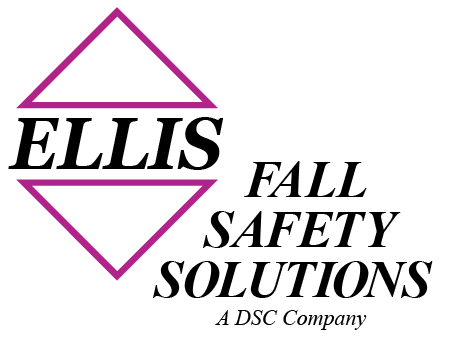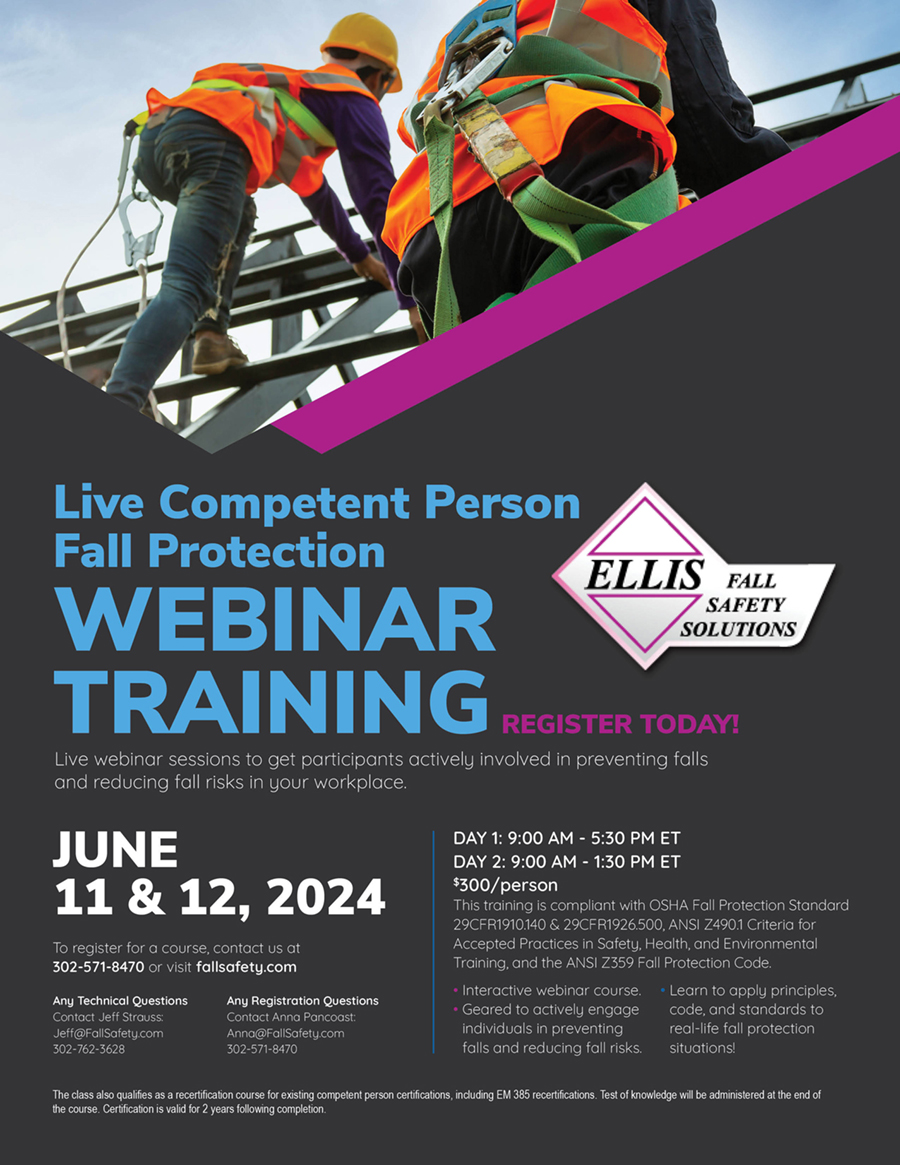Tip of the Week No. 221 – 09/29/08 – Steel Erection
Plan erection at ground level, if possible, by discussing it with the fabricator; then lift the assembly (possibly requiring stronger splice plates) into position.
This all but eliminates fall hazards.
See “Introduction to Fall Protection, 3rd Edition” page 253.
This book is an invaluable resource for every safety manager’s library. Click here to find out about ordering a copy. Order online now.
Tip of the Week No. 212 – 07/07/08 – Steel Erection
Steel erection includes the following: The movement and erection of skeleton steel members (structural steel), including initial connecting, moving point-to-point, installing metal floors or roof decking, welding, bolting and similar activities.
Steel erection also includes these activities when structural steel is installed on concrete an masonry walls or supports.
See “Introduction to Fall Protection, 3rd Edition” page 400.
This book is an invaluable resource for every safety manager’s library. Click here to find out about ordering a copy. Order online now.
Tip of the Week No. 211 – 06/30/08 – Steel Erection
Plan the location of bundles of decking so that a platfomr can be erected immediately next to the first bundle and widened without the necessity of carrying or dragging deck panels along steel beams or further than 20 to 30 feet.
A fall protection plan can be established to complement the selected work method. Fatality records show that decking work is the most dangerous phase of steel erection.
“Introduction to Fall Protection, 3rd Edition” page 253.
This book is an invaluable resource for every safety manager’s library. Click here to find out about ordering a copy. Order online now.
Tip of the Week No. 168 – 07/09/07 – Steel Erection
Steel Erection:
Plan the location of bundles of decking so that a platform can be erected immediately next to the first bundle and widened without the necessity of carrying or dragging deck panels along steel beams or further than 20 to 30 feet.
A fall protection plan can be established to complement the selected work method.
Fatality records show that decking work is the most dangerous phase of steel erection.
See “Introduction to Fall Protection, 3rd Edition” page 253.
This book is an invaluable resource for every safety manager’s library. Click here to find out about ordering a copy. Order online now.
Tip of the Week No. 96 A – 12/19/05 – Steel Erection
Plan (steel) erection at ground level, if possible, by discussing it with the fabricator; they lift the assembly (possibly requiring stronger splice plates) into position.
This all but eliminates fall hazards.
OSHA has proposed that a minimum coefficient of friction (COF) of 0.5 for walking on painted or coated steel become effective within 3 years after a revised steel erection standard is published.
See “Introduction to Fall Protection, 3rd Edition” page 253.
How about ordering a copy for yourself? Order online now.
Tip of the Week No. 104 – 03/13/06 – Steel Erection
Plan (steel) erection at ground level, if possible, by discussing it with the fabricator; then lift the assembly (possibly requiring stronger plice plates) into position.
This all but eliminates fall hazards.
See “Introduction to Fall Protection, 3rd Edition” page.253
This book is an invaluable resource for every safety manager’s library. Click here to find out about ordering a copy. Order online now.
Steel Erection
Ironworkers doing connecting work or handling structural steel members must have fall protection if they can fall 25 ft or more (30 ft if a floor is there), according to (then) OSHA Deputy Assistant Secretary Jim Stanley in his memo of July 25 1995. No citations are issued for less than 25 ft for tiered or non-tiered steel erection. Fall arrest requirements are still governed by 1926.104/5.
The SENRAC Committee proposals would have the height trigger at 30 ft for connecters of initial steel structural members before fall protection is required.
The base trigger height for fall protection in steel erection work would be 15 ft except for connecters. Each type of steel erection work is listed and also what is not considered steel erection in the forthcoming proposal.
Between 15 and 30 ft, connecters have the individual choice of being connected or not being connected. That means connecters must wear harnesses and the proper fall arrest system is provided to become active whenever the choice of fall protection is elected.
All fall protection must meet the requirements of 1926 SubPart M in these new proposals to come.
The big new benefit from the new proposed rules is that collapses are less likely which should result in fewer falls. This is due to the increased requirements for structural steel member attachment to reduce shearing such as four-bolting connections instead of two-bolting.
If the owner and GC elect a lower trigger height by contract or work rule or use guidelines such as 1926.500 which requires fall protection at six feet, then steel erectors and ironworkers must follow these rules. The penalty for defending a third party action comes back to the steel erector in most jurisdictions through the owner’s hold harmless contract clause.
The steel erection industry is presently moving to become acquainted with the new rules and try fall protection so that when the hearings are held, experience of fall protection use can be testified to. Warning!: watch out for fall arrest anchorage connectors at foot level which produce 11 ft falls using a six foot lanyard. These are presently popular but do not meet the system requirements of SubPart M when actually used.
The tower steel erection industry has produced a draft fall protection standard (NATE). OSHA still requires fall protection for climbing and working and has written a policy statement on tower climbing in 1/99 – check OSHA fall protection links on this site!
OSHA has shown that ironworker fall fatalities are very similar to the rest of the construction industry fall fatalities in terms of height (OH Magazine 7/91). In the OSHA Data Base 1985-89 on Construction Fatalities, over half the construction workers killed from falls have fallen less than 30 ft.
Tip of the Week No. 285 – 06/21/10 – Steel Erection
For steel erection:
Erect cables from waist height to overhead on beams or girders at the ground or shake-out level to provide protection for predictable routes. Use quick-release methods for release of hoisting slings.
See “Introduction to Fall Protection, 3rd Edition” page 253.
This book is an invaluable resource for every safety manager’s library. Click here to find out about ordering a copy. Order online now.
Tip of the Week No. 296 – 09/27/10 – Steel Erection
A System for Connector Fall Protection – Steel Erection
A vertical lifeline is attached to the column as ground level before it is lifted into place. This enables the connector to attach at a lower level and climb up with protection.
The horizontal lifelines are also attached at ground level while the beams are being rigged.
See “Introduction to Fall Protection, 3rd Edition” page 72.
This book is an invaluable resource for every safety manager’s library. Click here to find out about ordering a copy. Order online now.
Please select a category from the list below
- Aerial Lifts/Platforms
- Anchorage Points
- Calculations
- Construction Contracts
- Consulting
- Cranes
- Descent Devices
- Ellis Articles
- Ellis Presentations
- Equipment Maintenance
- Ergonomics/Human Factors
- Fall/Safety Statistics
- FP systems, programs
- Guardrails
- Harnesses, FP Equipment, HLL, SRL
- Hazards
- Holes/Pits
- Ladders
- Lanyards/Twin Tail Lanyards
- Misc.
- Nets
- New
- NIOSH
- OSHA News/Citations
- PFAS
- Rescue
- Roofs
- Ropes
- Safety Cases
- Safety Organizations
- Scaffolds
- Skylights
- Stairs
- Standard/Regulations
- Steel Erection
- Tanks
- Towers
- Training
- Tree Stands
- Trucks
- Tying Off
- Veterans of Safety
- Window Cleaners
- Workers Comp

